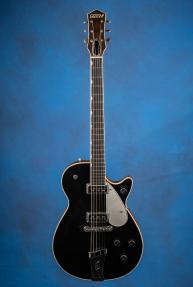A Rather Interesting 1956 Gretsch 6128 Duo Jet
1956 Gretsch 6128 Duo Jet
This 13 1/4-inch-wide semi-solid body guitar weighs just 7.20 lbs. and has a nice, fat nut width of just over 1 11/16 inches and a scale length of 24 1/2 inches. Chambered mahogany body, pressed arched top with black plastic laminate. One-piece mahogany neck with a thin-to-medium thick profile. Bound ebony fretboard with 22 original medium-thin frets and neo-classic inlaid pearloid thumbprint (half-moon) position markers. Headstock with inlaid pearl Gretsch "T-roof" logo. Two-layer (black on white) plastic truss-rod cover secured by three screws. Individual Grover StaTite open-back tuners with oval metal buttons. The top of the guitar is triple-bound and the headstock and fretboard are single-bound. Two single-coil DeArmond pickups with outputs of 9.30k and 9.18k. Clear Lucite pickguard painted silver from the underneath with no logo**. Four controls -- two volume and one master tone on lower treble bout, one master volume on treble horn -- plus one three-way pickup selector switch on upper bass bout. Chrome "Arrow-through-G" knobs with cross-hatch pattern on sides. Inside the control cavity is a rectangular orange, gray, and white label with the model number ("6128") stamped in blue and the serial number ("18764") stamped in black. The serial number is also engraved on the outside of the plastic control cavity cover. The pots are stamped "615 07 033 RC 542" (ROC October 1955). Melita Synchro-Sonic bridge and chrome cut-out "G-hole flat" tailpiece. This guitar is in exceptionally fine (9.00) condition. The black top is unmarked, the binding sound and free from the dreaded disintegration 'rot'. There a few areas of surface loss to the back and edges of the guitar, and the back of the neck shows good honest playing-wear behind the first seven frets only. The first five frets show moderate playing wear on the first five frets only. This fifty-nine year old guitar is in excellent plus (8.75) condition and has been set-up with 10-46 strings and plays and sounds just as it should. Housed in a slightly later Gretsch (ca. 1960) two-tone gray hardshell case with four latches and purple plush lining, the fabric a little worn on the edges (8.75).
An intriguing guitar: this Duo Jet comes from the second 1956 batch (serial 187xx), with potentiometers correctly dated October 1955 (per Ed Ball’s Gretsch guide). Like a number of ’56 Jets, it appears to have been returned to the Gretsch Brooklyn factory circa 1959 for a warranty re‑neck, gaining Neo‑Classic thumbnail inlays, a silver lucite pickguard with no logo, and a neck dowel - yet, very unusually, it does not have the expected zero fret which had become standard by 1959. It is possible that the guitar was returned to the Gretsch Brooklyn factory in 1958 as this was the first year of the 'neck dowel' - the zero fret was not introduced until 1959. The body and electronics remain totally original, making the neck configuration the notable outlier.
Neck resets or replacements were often factory service for guitars experiencing playability or alignment issues, especially given changes Gretsch made to neck angle or scale over time.
"In 1953 Gretsch launched its first solidbody, the $230 Duo Jet. In fact, while the guitar looked like a solid and certainly recalled the general outline and visuals of the $225 Gibson Les Paul, underneath things were somewhat different. At the time, Gibson used a sturdy sandwich of mahogany and maple for the Les Paul's body, while Fender used solid ash for its Telecaster. Gretsch, however, assembled the just-over-13-inch-wide body of the Duo Jet from several pieces of mahogany, incorporating a number of routed channels and pockets for cables and components, and adding a pressed arched top as a 'lid'. The most accurate description of Gretsch's new 'solid' guitar is probably 'semi-solid'. But in terms of its look, function, catalogue description and intended place in the market, the Duo Jet was in effect Gretsch's first solidbody electric guitar…Unusually, during its early years the new Duo Jet's body had a front covered in black plastic material, as used on some Gretsch drums. The guitar's control layout marked the start of Gretsch's fondness for positioning a master volume knob down on the cutaway bout rather than with the other controls…The Jet came with Gretsch's unique two-piece strap buttons -- an early take on the idea of locking strap buttons…The model also featured the Melita Synchro-Sonic bridge" (Tony Bacon, 50 Years of Gretsch Electrics, pp. 20-21).
George Harrison bought a 1957 Gretsch Duo Jet early in 1961. "Harrison used the Duo Jet throughout the group's rise to fame, only retiring it when he acquired a double-cutaway Gretsch Country Gentleman in summer 1963" (Tony Bacon, Electric Guitars: The Illustrated Encyclopedia, p. 164).


















